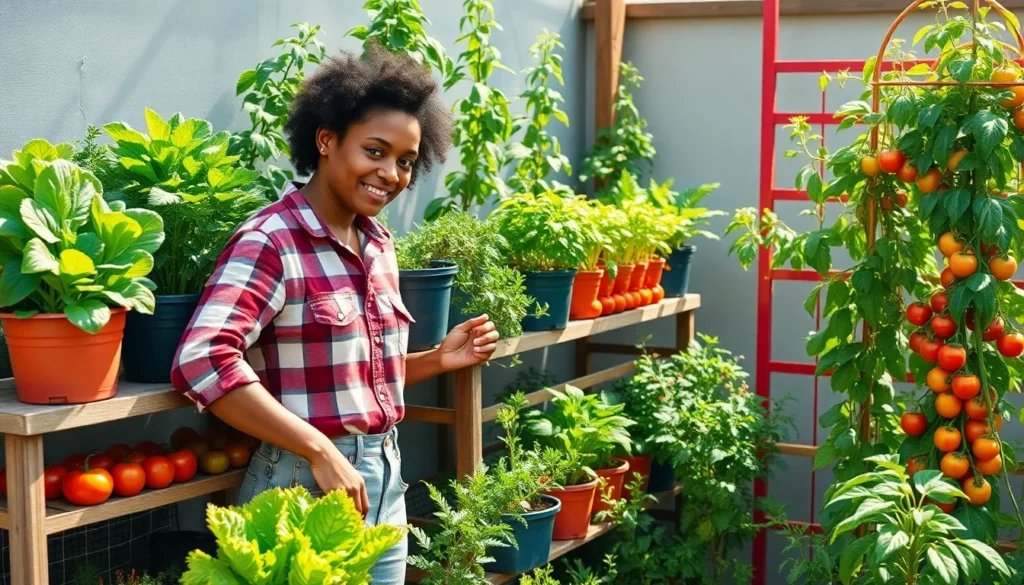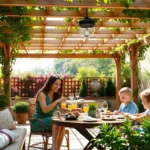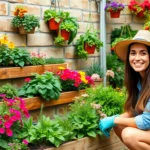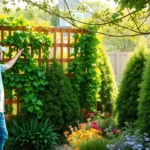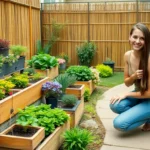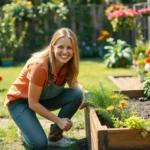Growing your own vegetables doesn’t require acres of land or years of gardening experience. We’ve discovered that even the smallest spaces can yield impressive harvests when you apply the right strategies and choose suitable crops. Whether you’re working with a tiny backyard, balcony, or patio, we’ll show you how to maximize every square inch.
Small vegetable gardens offer unique advantages that larger plots simply can’t match. They’re easier to maintain, require less water, and allow you to focus your energy on growing exactly what your family loves to eat. We’ve seen beginners transform compact spaces into productive food sources that rival traditional gardens.
The key lies in smart planning and creative answers. From vertical growing techniques to container gardening and space-saving plant varieties, we’ll explore practical ideas that turn limitations into opportunities. You’ll discover how to create a thriving vegetable garden that fits your lifestyle and delivers fresh, homegrown produce throughout the growing season.
Start With Container Gardening for Maximum Flexibility
Container gardening transforms any small space into a productive vegetable haven. We’ve found this approach gives us complete control over soil quality and plant placement.
Choose the Right Size Containers
Small vegetables like lettuce and herbs thrive in containers measuring 6-8 inches deep. We recommend these compact options for beginners wanting quick results with minimal investment.
Medium-sized crops such as peppers and bush beans need containers between 12-18 inches deep. These vegetables develop more extensive root systems and require additional growing space to produce quality harvests.
Large vegetables including tomatoes and eggplants demand containers at least 20-24 inches deep. We’ve discovered these deeper containers prevent root binding and support healthy plant development throughout the growing season.
Width matters as much as depth when selecting containers for your small garden. Most vegetables need containers at least 12 inches wide to accommodate proper root spread and prevent overcrowding.
Select Proper Drainage Systems
Drainage holes should measure at least ½ inch in diameter and appear every 6-8 inches across the container bottom. We drill additional holes if our containers lack adequate drainage to prevent waterlogged soil conditions.
Gravel layers create effective drainage when placed 1-2 inches deep at container bottoms. This barrier prevents soil from blocking drainage holes while allowing excess water to escape freely.
Raised feet or pot stands elevate containers 2-3 inches above ground surfaces. We use these supports to improve airflow underneath containers and ensure proper water drainage during heavy rainfall.
Saucers collect excess water but shouldn’t remain filled for extended periods. Empty these water catchers within 30 minutes after watering to prevent root rot and pest breeding.
Pick Portable Options for Seasonal Changes
Wheeled planters make moving heavy containers effortless when temperatures shift. We attach caster wheels to larger containers holding tomatoes and peppers for easy relocation during extreme weather.
Lightweight materials like fabric grow bags and resin containers reduce overall weight by 30-50% compared to ceramic or concrete options. These portable alternatives allow us to rearrange our garden layout throughout growing seasons.
Modular systems stack and connect multiple containers for flexible garden configurations. We use these interlocking designs to create vertical growing walls that adapt to changing space requirements.
Seasonal rotation becomes simple when containers move easily between sunny and shaded locations. Our portable setup allows vegetables to follow optimal sun patterns as seasons change from spring through fall.
Utilize Vertical Growing Techniques to Save Space
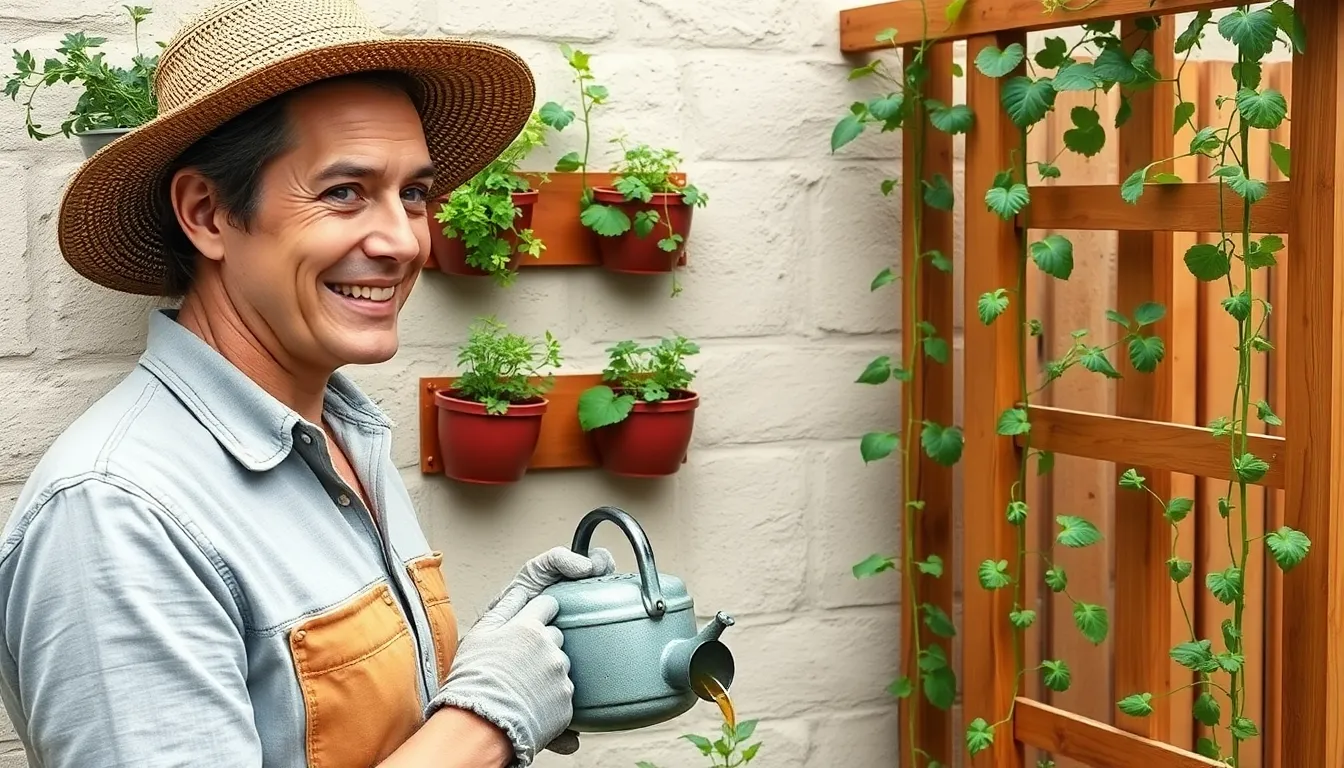
Taking your container gardening to the next level means thinking upward rather than outward. Vertical growing maximizes your limited garden space by using height instead of ground area, allowing you to grow more vegetables in the same footprint.
Install Wall-Mounted Planters
Wall-mounted planters transform unused vertical surfaces into productive growing space for your small vegetable garden. We recommend mounting these planters on fences, exterior walls, or garden structures to grow herbs like basil, oregano, and thyme, plus small vegetables such as cherry tomatoes and lettuce.
Positioning these planters near your kitchen door creates convenient access for harvesting fresh ingredients while cooking. Choose planters with proper drainage holes and lightweight materials to prevent wall damage. Mount them at comfortable heights for easy maintenance and watering.
Build Trellises for Climbing Vegetables
Trellises support climbing vegetables that naturally grow upward, saving valuable ground space in your small garden. We suggest building trellises for vegetables like peas, beans, cucumbers, and indeterminate tomatoes that thrive with vertical support.
Installing trellises improves air circulation around your plants, reducing disease problems common in cramped growing spaces. Position them to face south or southwest for optimal sunlight exposure. Use sturdy materials like cedar or treated lumber that can support the weight of mature, fruit-laden plants.
Create Tiered Garden Shelving
Tiered shelving systems multiply your growing capacity by stacking containers at different heights throughout your vertical space. We design these multi-level structures to accommodate various pot sizes, from small herb containers on top shelves to larger vegetable planters on lower, sturdier levels.
Building tiered shelves allows you to group plants by their sun and water requirements, creating microclimates within your small garden space. Place sun-loving vegetables like peppers and tomatoes on upper tiers while positioning shade-tolerant leafy greens like spinach and lettuce on lower shelves. Use weather-resistant materials and ensure each level receives adequate drainage to prevent water damage to lower plants.
Design Raised Bed Gardens for Better Organization

Raised beds offer superior control over soil quality and drainage while making garden maintenance more accessible for small space gardeners. We’ll explore three strategic approaches to maximize your raised bed efficiency.
Construct Space-Efficient Square Foot Gardens
Square foot gardening transforms raised beds into highly organized growing spaces by dividing each bed into 1×1 foot squares. We recommend using wooden dividers or string to create these sections, allowing for dense planting patterns that maximize yield per square foot.
Dense planting becomes possible when we group vegetables according to their mature size within each square. Leafy greens like lettuce and spinach thrive when planted 4-6 plants per square, while larger vegetables like tomatoes require one full square each.
Crop rotation simplifies dramatically with this method since we can easily track what grows in each square throughout the season. We suggest keeping a simple grid map to record plantings and ensure we don’t repeat the same plant families in identical squares year after year.
Build Multi-Level Raised Bed Systems
Tiered bed construction increases growing space vertically when horizontal space remains limited. We create multiple levels using stepped wooden frames or stacked stone retaining walls that follow natural slope contours.
Vertical elements like trellises integrate seamlessly into multi-level systems, supporting climbing plants such as peas, beans, and cucumbers on the upper tiers. We position these climbing supports on the north side of beds to prevent shading shorter plants below.
Water management improves naturally with tiered systems since excess water flows from upper beds to lower ones. We install this drainage system by ensuring each level has proper outlets that direct water to the next tier down.
Plan Companion Planting Layouts
Companion planting maximizes raised bed productivity by pairing vegetables that benefit each other’s growth patterns. We plant marigolds alongside tomatoes to deter harmful pests while attracting beneficial insects that improve pollination.
Strategic plant arrangement considers mature plant sizes and growth habits to optimize sunlight exposure and air circulation. We place taller plants like corn or pole beans on the north side of beds, with shorter vegetables like lettuce and radishes positioned to receive filtered morning light.
Nutrient sharing occurs when we pair heavy feeders like tomatoes with nitrogen-fixing plants such as beans, creating natural fertilization cycles within our raised beds. We rotate these partnerships seasonally to maintain soil health and prevent nutrient depletion.
Maximize Growing Seasons With Succession Planting
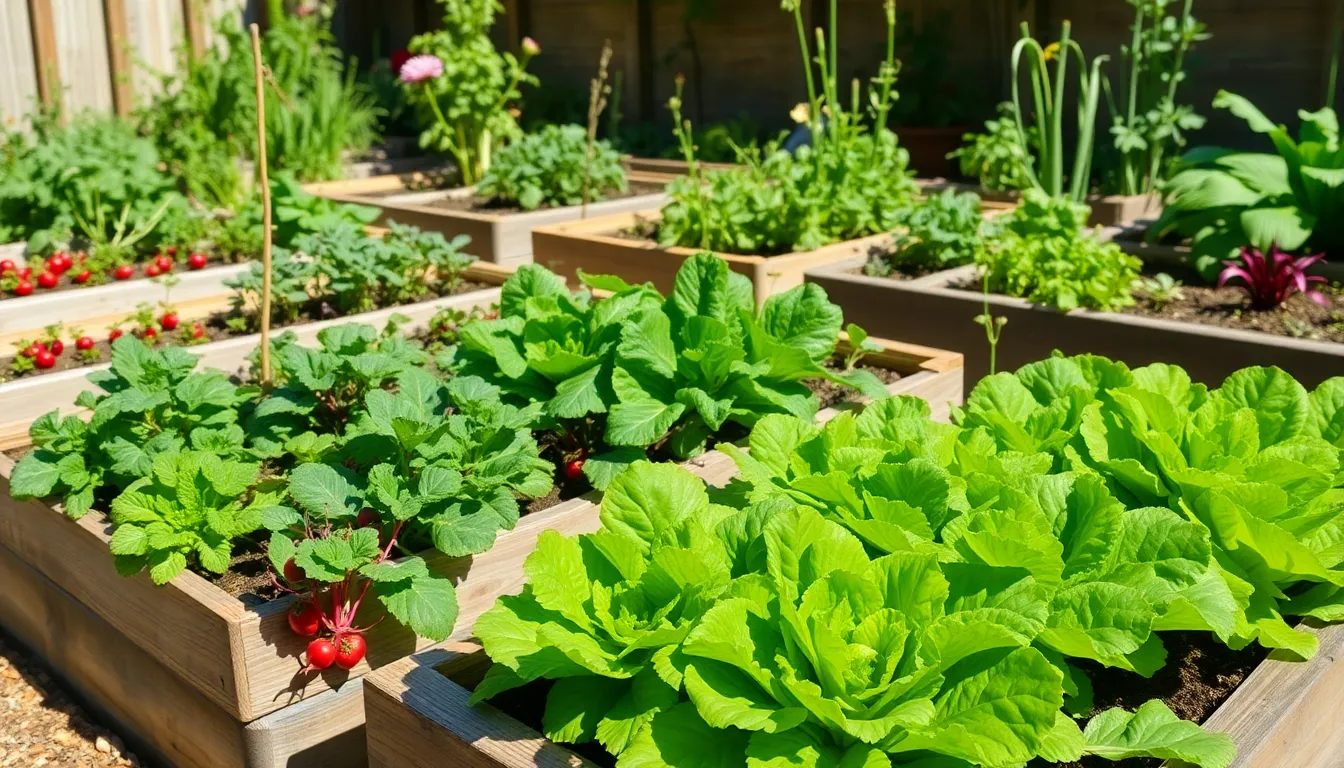
Succession planting transforms our small vegetable gardens into continuous production powerhouses throughout the year. This strategic approach ensures we’re never without fresh produce while making the most of our limited growing space.
Stagger Planting Times for Continuous Harvest
Planting seeds every few weeks creates a steady supply of vegetables rather than overwhelming harvests followed by empty periods. We recommend spacing plantings 2-3 weeks apart for most crops to maintain consistent availability. Lettuce plantings work exceptionally well with this method, allowing us to harvest fresh greens continuously instead of watching entire crops bolt simultaneously.
Fast-growing crops like radishes and spinach benefit most from staggered timing since they mature quickly and can be replanted multiple times per season. Bush beans planted every 3 weeks provide fresh pods from early summer through fall. Carrots staggered at 2-week intervals ensure we’re pulling tender roots throughout the growing season rather than storing large quantities.
Small space gardeners can maximize their container systems by rotating plantings within the same pots. We replace harvested lettuce immediately with new seedlings, keeping productive capacity at 100%. This approach works particularly well in our raised bed squares, where we can dedicate exact sections to continuous rotation cycles.
Choose Fast-Growing Vegetable Varieties
Fast-growing vegetables maximize our harvest potential in compact growing areas by providing quick returns on our investment. Radishes mature in just 25-30 days, making them perfect for filling gaps between longer-season crops. Baby lettuce varieties can be harvested in 30-40 days, allowing multiple successions throughout the growing season.
Microgreens offer the fastest turnaround at 7-14 days from seed to harvest, perfect for windowsill container gardens. These nutrient-dense vegetables require minimal space while providing maximum flavor impact for our cooking. Arugula, mustard greens, and pea shoots thrive in shallow containers and can be continuously harvested.
Bush varieties of traditionally large vegetables work better than their sprawling counterparts in our confined spaces. Bush beans produce pods in 50-60 days compared to pole varieties that take longer but require vertical support. Cherry tomatoes in containers mature faster than full-size varieties while producing abundant fruit throughout the season.
Plan Cool-Season and Warm-Season Rotations
Cool-season crops like broccoli and spinach thrive in spring and fall temperatures, allowing us to use our growing space during shoulder seasons. These vegetables prefer temperatures between 60-70°F and can tolerate light frosts. We plant them 4-6 weeks before the last spring frost and again 10-12 weeks before the first fall frost.
Warm-season crops like tomatoes and peppers dominate our summer growing schedule when temperatures consistently stay above 70°F. These heat-loving plants require our warmest, sunniest locations and shouldn’t be planted until soil temperatures reach 60°F. Summer squash and cucumbers also fall into this category, producing heavily during peak heat periods.
Strategic rotation planning allows us to grow three distinct seasons of vegetables in the same containers or raised bed squares. Spring plantings of peas and lettuce give way to summer tomatoes and peppers, followed by fall crops of kale and carrots. This rotation system keeps our soil productive year-round while preventing pest and disease buildup that occurs when growing the same plant families repeatedly.
Select Compact and High-Yield Vegetable Varieties
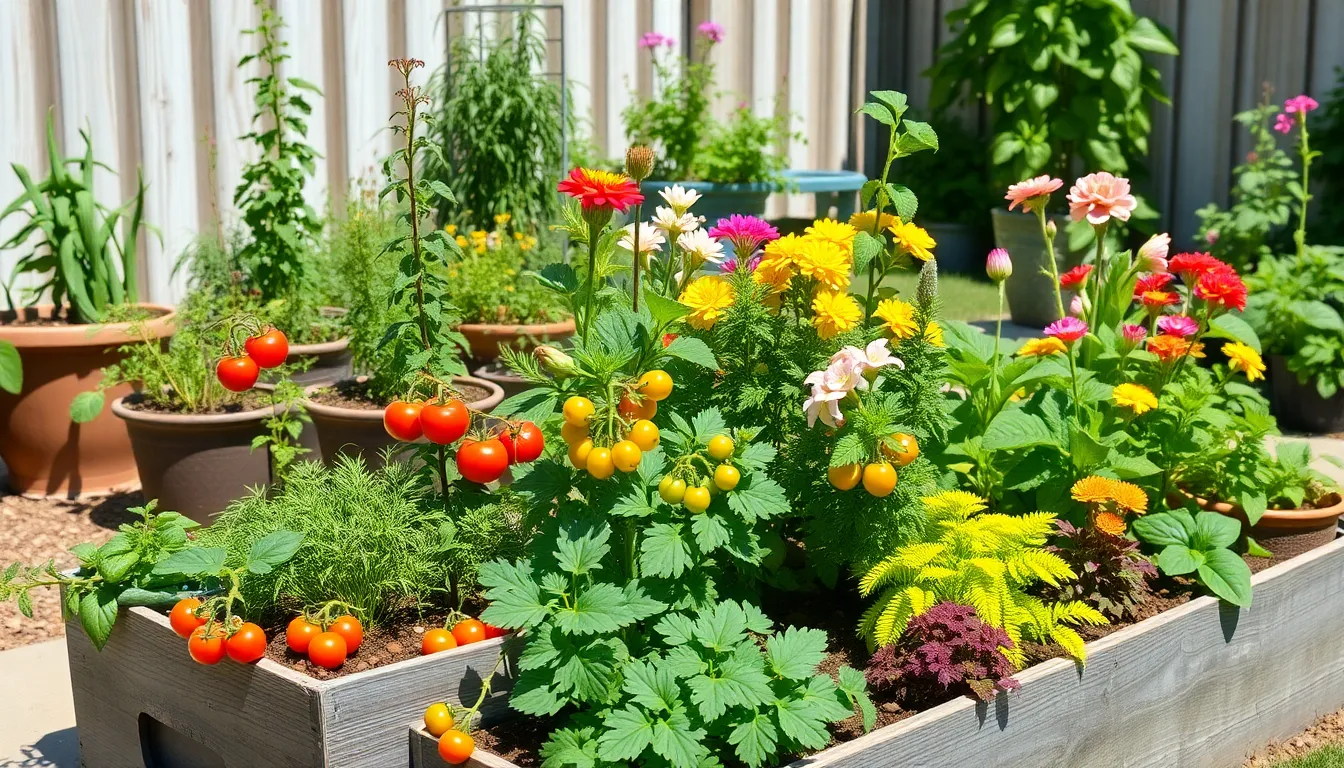
Choosing the right vegetable varieties can make or break our small garden success. Compact varieties deliver impressive yields while requiring minimal space, allowing us to grow more food in less area.
Choose Dwarf and Bush Varieties
Dwarf tomato varieties like Cherry Cascade thrive in small spaces and hanging baskets, producing abundant cherry tomatoes throughout the season. These compact plants eliminate the need for extensive staking systems while delivering continuous harvests.
Bush bean varieties such as Blue Lake Bush Beans offer exceptional yields without requiring support structures. We can plant these space savers directly in containers or small garden plots, and they’ll produce tender beans for weeks.
Compact eggplant varieties including Patio Baby and Fairy Tale generate high yields in minimal space. These dwarf plants fit perfectly in containers while producing full sized, flavorful eggplants ideal for small family meals.
Container friendly peppers like Black Hungarian and Patio Fire hot peppers serve dual purposes as ornamental plants and productive crops. We get beautiful foliage plus spicy peppers from these compact varieties that thrive in pots.
Dwarf herb varieties including basil, thyme, and rosemary grow easily in small spaces while providing continuous harvests. These compact plants fit on windowsills, balconies, or small garden corners.
Focus on Cut-and-Come-Again Crops
Leafy green vegetables such as lettuce, spinach, and chard provide continuous harvests when we pick outer leaves regularly. We can harvest these crops for months from a single planting, maximizing our space investment.
Fresh herb varieties like basil and cilantro encourage new growth after cutting, giving us multiple harvests throughout the season. Regular harvesting actually promotes bushier growth and extended production periods.
Salad mix varieties allow us to harvest young tender leaves repeatedly while plants continue growing. We get fresh salads for weeks from small plantings of mixed greens.
Swiss chard varieties produce colorful stems and nutritious leaves that regrow after cutting. These productive plants deliver harvests from spring through fall in small garden spaces.
Pick Space-Saving Root Vegetables
Compact cucumber varieties including Salad Bush and Spacemaster grow well in containers while producing full sized cucumbers. We can grow these space efficient varieties in deep pots or raised beds without sprawling vines.
Quick growing radishes mature rapidly in shallow containers and provide fast returns on our garden investment. These root vegetables fit into small spaces between other plants and harvest in just 30 days.
Container suitable carrots grow successfully in deep containers or raised beds when we choose shorter varieties. We need at least 12 inches of soil depth for most carrot varieties to develop properly.
Compact beet varieties thrive in containers while providing both nutritious roots and edible greens. These dual purpose vegetables maximize our harvest potential in limited growing space.
Create Micro-Gardens in Unusual Spaces
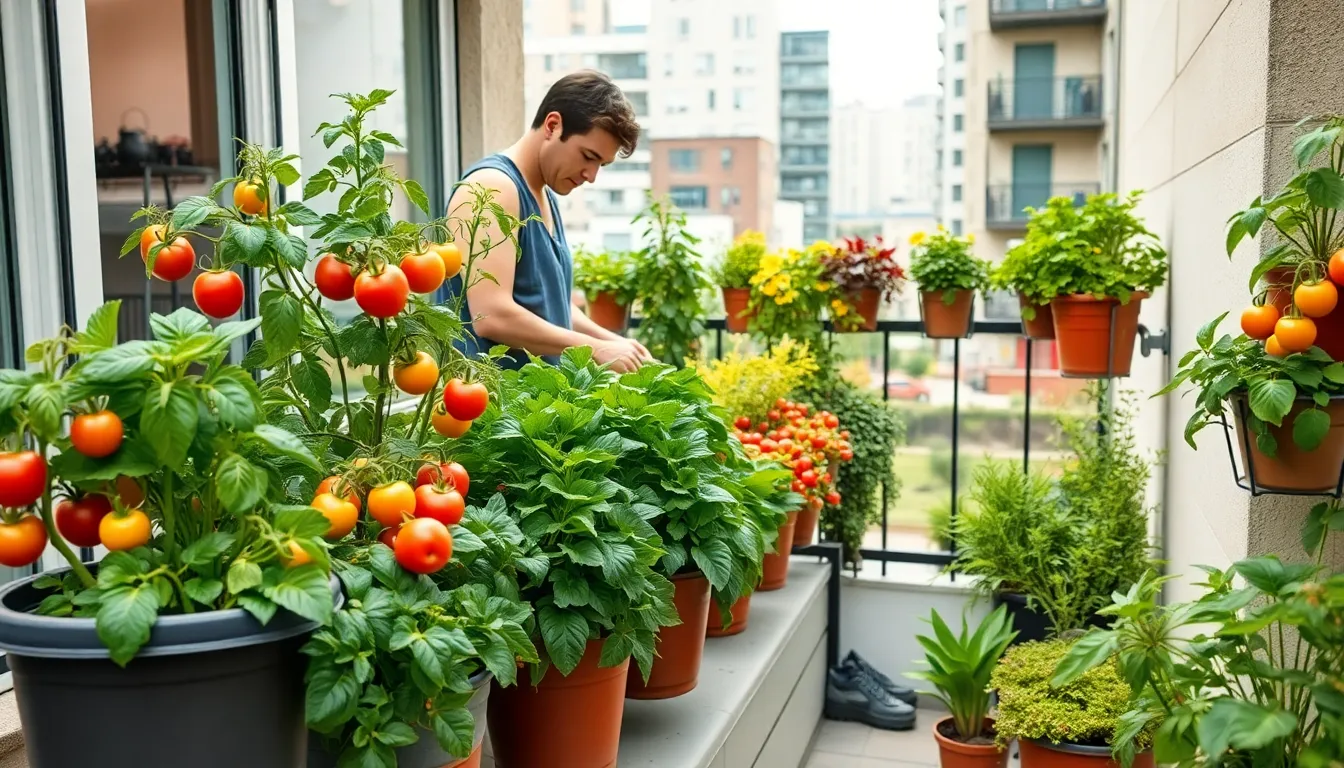
We’ll explore unconventional locations that transform underutilized areas into productive growing spaces. These innovative approaches maximize our gardening potential without requiring traditional outdoor space.
Transform Balconies Into Productive Gardens
Balcony gardens offer excellent opportunities for growing fresh vegetables in compact urban environments. High-yield containers provide the foundation for successful balcony gardening, with deep containers measuring 12-18 inches accommodating root vegetables like carrots and beets. Railings become valuable real estate when we attach specialized planters that expand our growing capacity without consuming floor space.
Strategic container placement maximizes sunlight exposure throughout the day. We position taller plants like tomatoes and peppers on the outer edges while keeping shorter crops like lettuce and herbs closer to the building. Wind protection becomes essential for balcony gardens, so we create barriers using taller plants or install screens to shield delicate vegetables from strong gusts.
Weight distribution requires careful planning to ensure balcony safety. Lightweight containers made from resin or fiberglass work better than heavy ceramic pots, and we spread the load evenly across the balcony structure. Wheeled planters provide mobility for seasonal adjustments and maintenance access.
Convert Window Boxes for Herb Production
Window boxes transform exterior windows into productive herb gardens with minimal setup requirements. Herb selection focuses on compact varieties that thrive in shallow containers, including basil, mint, and chives that provide fresh flavors year-round. These aromatic plants require only 6-8 inches of soil depth, making them perfect candidates for standard window box dimensions.
Drainage systems prevent waterlogging and root rot in window installations. We drill adequate drainage holes in the bottom of each box and add a layer of gravel before filling with potting mix. Proper spacing between herbs allows air circulation while preventing overcrowding that leads to disease issues.
Maintenance routines keep window box herbs healthy and productive. Regular harvesting encourages continued growth, and we pinch flowers to maintain leaf production in herbs like basil and oregano. Weekly watering schedules adapt to seasonal changes, with more frequent watering during hot summer months.
Develop Indoor Growing Stations
Indoor growing stations enable year-round vegetable production regardless of weather conditions. Hydroponic systems eliminate soil requirements while providing precise nutrient control for crops like lettuce and spinach. These soilless growing methods use 90% less water than traditional gardening while producing faster growth rates.
LED lighting systems replace natural sunlight for indoor cultivation success. We install full-spectrum LED grow lights that consume less energy while providing optimal light wavelengths for photosynthesis. Plants requiring less sunlight, such as leafy greens and herbs, flourish under these controlled lighting conditions.
Temperature and humidity control create ideal growing environments indoors. Consistent temperatures between 65-75°F support most vegetable varieties, while humidity levels around 50-60% prevent fungal issues. Air circulation fans prevent stagnant air that encourages pest problems and disease development in enclosed growing spaces.
Implement Intensive Planting Methods
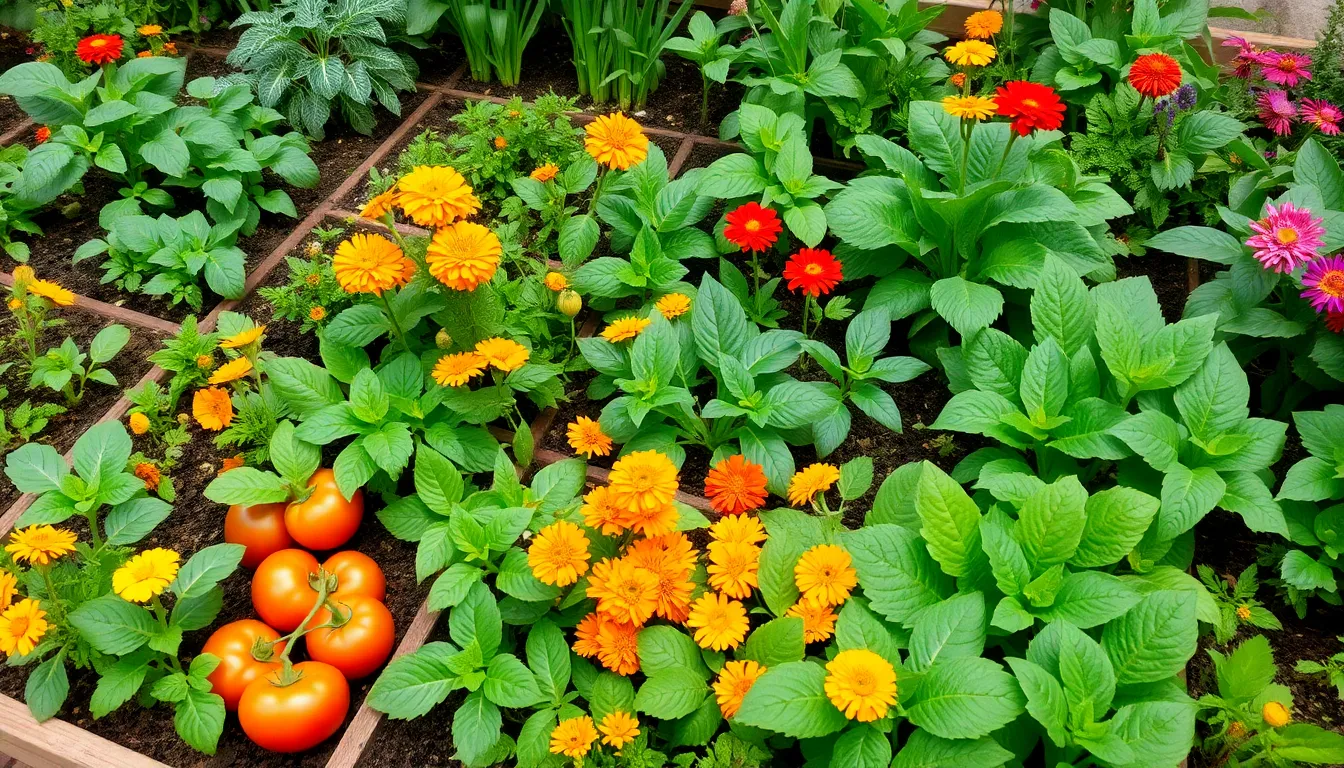
Intensive planting transforms small garden spaces into highly productive areas by concentrating our soil preparation efforts and maximizing every square inch available. We can achieve remarkable results by growing plants closer together than traditional spacing recommendations suggest.
Practice Interplanting Compatible Vegetables
Interplanting involves strategically growing different vegetables together that naturally complement each other’s growth patterns and needs. We discover that certain plant combinations create beneficial relationships, such as planting marigolds alongside tomatoes to naturally deter harmful pests while attracting beneficial insects.
Companion planting combinations like beans and corn follow traditional “Three Sisters” methods that improve soil health through nitrogen fixation. Lettuce thrives when planted between taller crops like peppers, creating natural shade during hot summer months. Basil planted near tomatoes not only repels insects but also enhances the flavor of both crops when they’re growing in close proximity.
Chinese cabbage works exceptionally well as an interplanting crop because its shallow root system doesn’t compete with deeper rooted vegetables. We can plant quick growing herbs like cilantro and dill between slower developing vegetables to maximize space usage throughout the growing season.
Use Succession Planting in the Same Space
Succession planting ensures continuous harvests by planting new seeds or seedlings in the same space shortly after previous crops have been harvested. Fast growing vegetables like radishes mature in just 30 days, allowing us to plant multiple crops in the same location throughout a single growing season.
Small leafy greens such as lettuce and spinach are ideal candidates for succession planting because they mature quickly and don’t require extensive root systems. We can plant new lettuce seeds every two weeks to maintain a steady supply of fresh greens for our kitchen table.
Root vegetables like radishes and turnips work perfectly for succession planting since they grow rapidly and can be harvested before larger plants need the space. Cool season crops allow us to continue planting through fall and early spring, extending our growing season significantly beyond traditional gardening timelines.
Apply Square Foot Gardening Principles
Square foot gardening divides raised beds into individual 1 foot by 1 foot sections, with each square dedicated to a exact crop based on plant size requirements. This grid system maximizes space efficiency while reducing waste by utilizing every available inch of growing area.
Large plants like tomatoes and peppers occupy one full square each, while medium sized vegetables such as lettuce can fit four plants per square. Small crops like radishes accommodate 16 plants per square foot, demonstrating how this method dramatically increases planting density compared to traditional row gardening.
Grid organization makes crop rotation simple because we can easily track what was planted in each square during previous seasons. Planning becomes straightforward when we know exactly how many plants fit in each designated space, eliminating guesswork and preventing overcrowding that reduces yields.
Incorporate Space-Saving Garden Structures
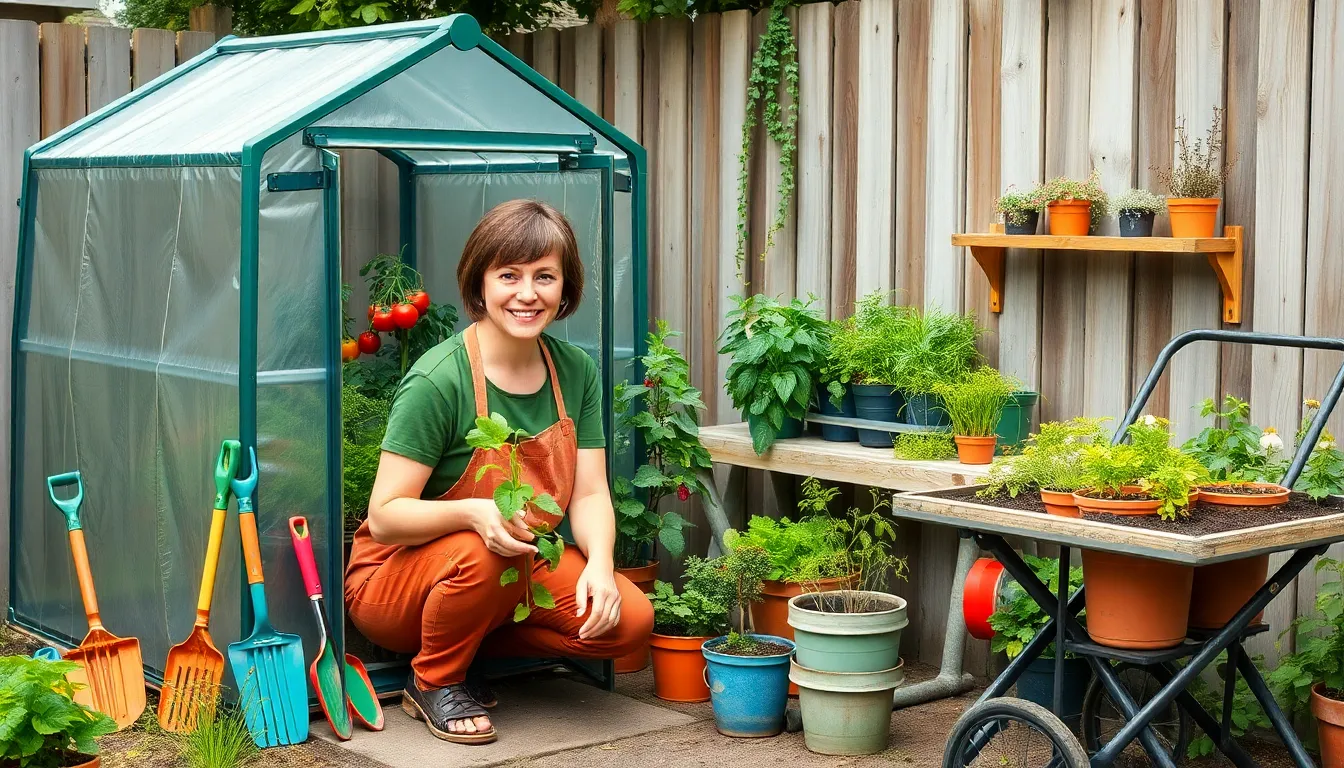
Smart structural additions can transform even the tiniest garden spaces into highly productive growing areas. We’ll explore innovative answers that maximize vertical space while providing essential support for our vegetable plants.
Install Compact Greenhouse Answers
Mini greenhouses revolutionize small space gardening by extending our growing season and protecting plants from unpredictable weather conditions. We can choose from portable greenhouse options that easily move around our garden as needed, or select wall mounted units that attach directly to fences or building sides.
Cold frames offer another excellent microclimate solution for small vegetable gardens. Building these simple structures requires minimal materials yet provides important temperature control for our plants during transitional seasons. We can construct cold frames using old windows and scrap lumber, creating an affordable way to start seedlings earlier and harvest crops longer.
These greenhouse answers work particularly well for protecting tender vegetables like tomatoes, peppers, and herbs during unexpected cold snaps. We’ll find that even basic cold frame structures can extend our growing season by 4 to 6 weeks on both ends of the traditional planting calendar.
Build Fold-Down Potting Benches
Fold down potting benches create essential workspace without permanently consuming precious garden real estate. We can mount these benches to fence posts, garage walls, or garden shed sides, providing a sturdy surface for seed starting, transplanting, and plant maintenance tasks.
Designing our benches with built in storage compartments maximizes their functionality while keeping tools and supplies organized. We should include hooks for hanging small tools, shelves for seed packets, and bins for potting soil and fertilizers.
Most fold down bench designs require basic carpentry skills and common materials like hinges, brackets, and weather resistant lumber. We can customize the height and width to match our exact needs while ensuring the folded position doesn’t interfere with plant growth or garden pathways.
Create Mobile Garden Carts
Mobile garden carts serve dual purposes as both transportation devices and additional workspace in our small vegetable gardens. We can load these carts with harvested vegetables, gardening tools, or potted plants that need repositioning throughout the day for optimal sun exposure.
Wheeled carts with multiple tiers provide excellent storage for frequently used items while doubling as temporary potting stations when needed. We should select carts with sturdy wheels that navigate easily over garden paths, grass, and uneven terrain without damaging our plants or garden beds.
These versatile carts become especially valuable during planting and harvesting seasons when we need to move supplies and produce efficiently around our garden space. We can also use them to transport container plants indoors during severe weather or to different locations as seasonal sun patterns change.
Conclusion
Small vegetable gardens offer incredible potential when we apply the right techniques and strategies. By combining container gardening with vertical growing methods and intensive planting approaches we can transform any limited space into a productive food source.
The key lies in maximizing every square inch through thoughtful planning and creative answers. Whether we’re working with a tiny balcony or a small backyard plot these methods allow us to grow fresh nutritious vegetables year-round.
We encourage you to start small and experiment with different techniques to discover what works best for your exact space and growing conditions. With patience and consistent care your compact garden will soon provide abundant harvests that rival much larger growing areas.
Frequently Asked Questions
What size containers do I need for different vegetables?
Small crops like lettuce and herbs need 6-8 inch deep containers, while medium vegetables like peppers and bush beans require 12-18 inch deep containers. Larger vegetables such as tomatoes and eggplants need 20-24 inch deep containers. Always ensure proper drainage with holes and gravel layers to prevent waterlogging.
How can I grow more vegetables in vertical spaces?
Install wall-mounted planters on fences for herbs and small vegetables, build trellises for climbing plants like peas and cucumbers, and create tiered garden shelving. This approach maximizes limited space by utilizing height while improving air circulation and creating microclimates for different crops.
What is square foot gardening and how does it work?
Square foot gardening divides raised beds into 1×1 foot squares for dense planting. This method allows for easy crop rotation, better organization, and tracking of plants. It maximizes space efficiency while simplifying garden management and enabling strategic companion planting arrangements.
Which vegetables are best for small space gardens?
Choose compact varieties like Cherry Cascade tomatoes, Blue Lake Bush Beans, and dwarf plants. Focus on cut-and-come-again crops like leafy greens and herbs that allow continuous harvesting. Quick-growing vegetables like radishes and baby lettuce provide fast returns and multiple harvests per season.
How does succession planting help maximize harvests?
Succession planting involves staggered planting times to maintain continuous crop production. Plant new seeds every 2-3 weeks and rotate between cool-season and warm-season crops throughout the year. This ensures steady harvests and prevents waste while maximizing your limited growing space.
Can I grow vegetables indoors year-round?
Yes, indoor growing stations with hydroponic systems and LED lighting enable year-round production. These controlled environments allow you to manage temperature, humidity, and lighting conditions for optimal plant growth, extending your growing season beyond outdoor limitations.
What are the benefits of companion planting in small spaces?
Companion planting pairs vegetables that benefit each other’s growth, such as marigolds with tomatoes to deter pests. This method optimizes sunlight exposure, maintains soil health, and maximizes productivity by creating beneficial relationships between plants while using space efficiently.
How can I garden on balconies and in small outdoor areas?
Use high-yield containers with proper weight distribution for safety. Focus on strategic plant placement to maximize sunlight exposure. Window boxes work well for compact herbs, while balcony gardens can accommodate larger containers with proper drainage and maintenance routines.

